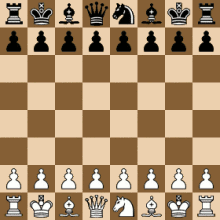|
Volver a la partida
Knightmate ChessThis variant, created by Bruce Zimov in 1972, introduces an interesting goal - to checkmate a knight instead of a king. It means that each player has one knight (at the standard king position) and two kings (at the standard knight positions) - see the next picture:
Regarding this modification, some classic Chess rules are changed as well:
Practicar este juego Ver también: Ajedrez, Xiangqi, Shogi, Ajedrez Aleatorio, Ajedrez Fortaleza, Ajedrez Horda, Ajedrez Cíclico, Anti Ajedrez, Ajedrez Extinción, Ajedrez Maharaja, Ajedrez Tres Jaques, Ajedrez Tuerto, Ajedrez Atómico, Ajedrez Jano, Ajedrez Embajada, Ajedrez Compuesto, Ajedrez Compuesto Loco, Ajedrez Cilíndrico, Ajedrez Amazonas, Ajedrez Berolina, Ajedrez Aleatorio de Fischer, Ajedrez Legan, Ajedrez C-Relevo, Gran Ajedrez, Ajedrez Aleatorio de Capablanca, Ajedrez Los Alamos, Ajedrez Ambiguo, MiniShogi, Ajedrez Dados, Ajedrez Reciclado, Ajedrez Edad de Hielo, Ajedrez Behemoth, Ajedrez Gato Cheshire, Ajedrez Mate al Caballo, Carrera de Reyes, Ajedrez Dados 10x10, Ajedrez Masacre |
Fecha y hora
Amigos conectados
Foros favoritos
Comunidades
Consejo del día
|
|
||||||||||||||||||||||||||||||||||||||||||||||||||||||||||||||||||||||||||
Copyright © 2002 - 2024 Filip Rachunek, todos los derechos reservados. Volver a arriba |





















